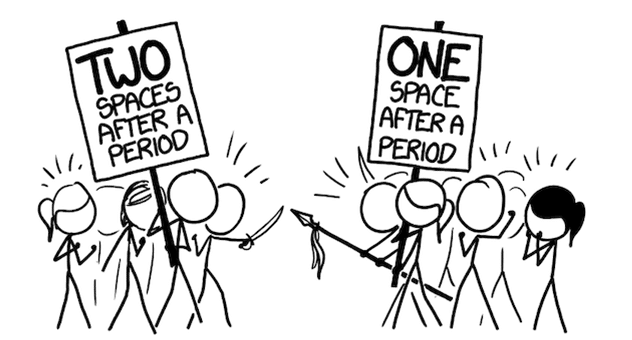

In the battle of spaces, no one can hear you scream.
The argument about whether to use one space or two after a full stop (aka period) is surprisingly heated. So, should you use one space at the end of a sentence? (Like this.) Or two? (Like this.)
Until the early twentieth century, guidelines were numerous and often contradictory. There were a variety of space sizes, such as the large ‘em-quad’ (traditionally the width of a capital ‘M’), the smaller ‘en-quad’ (the width of a capital ‘N’) and the even smaller 1/3 em (one third of the width of a capital ‘M’).
Typesetters followed various, sometimes complex, rules of style. Generally, the em-quad was used after full stops, while the en-quad was used after all other punctuation (for a detailed exploration, see this post).
Some of us were taught a similar rule in handwriting at school: a finger’s width between words, a thumb’s width between sentences.
When typewriters were invented in the 1860s, the practice of having a longer space between sentences was carried over. But instead of an em-space, typists simply used two normal spaces. This was where the ‘gappy’ look came in: two normal spaces are wider than one em.
By about 1950, most house styles had dropped the double space and agreed to use a single space in all instances. Today, almost every major style guide recommends this, including The Economist, the Guardian and the Chicago Manual of Style.
So, given this general consensus, is using two spaces after a full stop actually incorrect?
Some say it is, and pretty unequivocally too. It’s ‘totally, completely, utterly, and inarguably wrong’, according to American journalist Farhad Manjoo, writing on Slate.com. Worse, says Telegraph columnist Damian Thompson, it’s a ‘typographical atrocity’.
If you think this seems like a bit of an over-the-top reaction to what is essentially just a millimetre or so of white space, we agree. As writing style columnist ‘Johnson’ puts it in The Economist: ‘We’re barely in the territory of rules at all. The relevant concept here is not grammar but style.’
We would even go further and say that focusing on your own personal stylistic choices misses the point. The most important things about writing are not rules and style. The most important things are your reader, your message, and the reaction to what you’ve written.
And what’s the most common reaction readers have to double spaces after full stops? Simply: ‘It seems old-fashioned.’ Many people associate double spacing with a bygone era of clattering typewriters. Others find it makes text look gappy and distracting. And to some, defiantly typing two spaces comes across as pedantic. After all, we live in an age where modern fonts and software are designed for single spaces.
In contrast, single spaces make practically no impression on your reader at all – they’re so common as to be invisible. They’re unlikely to distract, so they won’t draw attention away from what you’re writing. Unless your reader happens to be a hardcore double-space campaigner, that is, but these are mercifully few in number.
So, should you use a single or double space? We strongly recommend just the one. It’s less likely to distract your reader from your message, which is more likely to help you achieve your goal. And at work, getting your writing to achieve what you need it to is the most important thing. Full stop (period).
Can you spot the one double space in this article? And [psychotherapist voice] how does it make you feel?
Image credit: xkcd
Subscribe
Expert advice to your inbox


